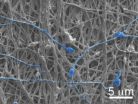(Press-News.org) SALT LAKE CITY – Given the right equipment, training and skill, an individual surgeon can expect to provide the best possible care on a consistent basis. But how do you get an entire system of surgeons — each with his or her own ideas, backgrounds, and routines — to provide that same level of care?
A series of studies directed by Intermountain Healthcare's Oncology Clinical Program shows that it's possible to improve care across the board if you tackle the problem in a standardized way, relying on the best evidence available.
"It sounds simple, but it's really very difficult," said John C. Ruckdeschel, MD, Medical Director of Intermountain's Oncology Clinical Program. "We've shown that with the right approach, we can make meaningful improvements in patient care, even across a very large and complicated hospital system."
The Intermountain team will present their findings at the American Society of Clinical Oncology's first-ever Quality Care Symposium, Nov. 30-Dec. 1, in San Diego.
The Oncology Clinical Program launched a project to improve care for breast cancer patients at all of Intermountain Healthcare's 22 hospitals. The effort took aim at a common problem in medicine: variation. For example, if two identical patients seek treatment from two different physicians, they may get two entirely different treatment approaches and outcomes.
The Intermountain cancer research team did a thorough review of the best scientific literature and national guidelines, developed a clinical score card for physicians to follow and made sure the doctors had access to the right equipment and resources. They did not remove a physician's ability to make decisions about patient care, but rather provided the richest tools with which to make the decision.
Almost a decade after the project began, care has improved across the system. Two examples:
Breast Preservation. After the project fewer women had a breast removed, with 58 percent of women having a mastectomy in 1998, compared with 25 percent of women 10 years later.
Lymph Node Removal. Fewer women had invasive surgery to remove all lymph nodes under the arm, and instead had just one or two "sentinel" nodes examined to see if cancer had spread. Before the project began, about seven out of 10 women had sentinel node biopsy; after, the number rose to almost nine in 10.
The numbers show improvement for breast cancer patients, but the bigger picture means potentially better healthcare for everyone.
"This is the way medicine is moving today — toward finding ways to apply the best science and provide appropriate treatment," said Dr. Ruckdeschel. "Intermountain Healthcare is doing this as well as, if not better than, anyone else in the country. Other institutions are looking to us for ways to make those improvements."
###
In addition to the breast cancer research, the Intermountain Healthcare Oncology Clinical Program will also present two other abstracts on behalf of researchers and oncologists involved in quality improvement initiatives.
Intermountain Healthcare Cancer research provides possible road map for improving healthcare
A series of studies directed by Intermountain Healthcare's Oncology Clinical Program shows that it's possible to improve care across the board if you tackle the problem in a standardized way, relying on the best evidence available
2012-11-30
ELSE PRESS RELEASES FROM THIS DATE:
Grey-mouse lemurs serve as model for the early primates from which humans evolved
2012-11-30
New research shows first evidence of paternal voice recognition in solitary foraging species, provides insight into early primates from which humans evolved
Think of the last time you screamed. Chances are you attracted someone's attention. What about the last time someone flirted with you? You were likely more selective in your response.
New research findings from Arizona State University and the University of Veterinary Medicine Hannover in Germany demonstrate that a less social species – the grey-mouse lemur - pays attention to alarm calls regardless of whom they ...
Even brown dwarfs may grow rocky planets
2012-11-30
Rocky planets are thought to form through the random collision and sticking together of what are initially microscopic particles in the disc of material around a star. These tiny grains, known as cosmic dust, are similar to very fine soot or sand. However, in the outer regions around a brown dwarf -- a star-like object, but one too small to shine brightly like a star -- astronomers expected that grains could not grow because the discs were too sparse, and particles would be moving too fast to stick together after colliding. Also, prevailing theories say that any grains ...
Electrically spun fabric offers dual defense against pregnancy, HIV
2012-11-30
The only way to protect against HIV and unintended pregnancy today is the condom. It's an effective technology, but not appropriate or popular in all situations.
A University of Washington team has developed a versatile platform to simultaneously offer contraception and prevent HIV. Electrically spun cloth with nanometer-sized fibers can dissolve to release drugs, providing a platform for cheap, discrete and reversible protection.
The research was published this week in the Public Library of Science's open-access journal PLoS One. The Bill & Melinda Gates Foundation ...
When eating for 2 becomes a weighty issue
2012-11-30
Two-thirds of Australian mums-to-be are in the dark when it comes to how much weight they should gain during pregnancy.
Susie de Jersey from Queensland University of Technology's (QUT) Institute of Health and Biomedical Innovation (IHBI) and senior dietician at the Royal Brisbane and Women's Hospital said a third of women surveyed gained too much weight during pregnancy. Another third struggled to gain enough weight with some mothers recording a lower weight just before giving birth than they did before falling pregnant.
"The majority of the women in the study knew ...
The colour of love: Zebrafish perform colorful courtship displays
2012-11-30
Elaborate secondary sexual displays are often overlooked because many species attract mates through sensory modalities imperceptible to humans, including ultraviolet light, ultrasound, electrical signals, or pheromones. Also, sexual coloration may only be expressed briefly during courtship (ephemeral courtship dichromatisms) to avoid attracting predators. Zebrafish (Danio rerio) are a widely studied model organism, though there have been few studies on their mating behaviour. Like many schooling fish, zebrafish do not appear sexually dichromatic to humans; there are no ...
Help for European children to resist unhealthy temptations
2012-11-30
Children and young people in Europe are exposed to all kinds of fast food, crisps and fizzy drinks – so how can they learn to resist the temptation to indulge?
This is the question that the European research project TEMPEST was set up to answer. The research project involves researchers from nine European countries and one of the team members is Liliya Nureeva, a PhD student at Aarhus University.
The TEMPEST research project has prepared strategies for children to use to suppress or control their desire to scoff sweets and snacks. One of the main objectives of the ...
Clearest evidence yet of polar ice losses
2012-11-30
After two decades of satellite observations, an international team of experts brought together by ESA and NASA has produced the most accurate assessment of ice losses from Antarctica and Greenland to date. This study finds that the combined rate of ice sheet melting is increasing.
The new research shows that melting of the Antarctic and Greenland ice sheets has added 11.1 mm to global sea levels since 1992. This amounts to about 20% of all sea-level rise over the survey period.
About two thirds of the ice loss was from Greenland, and the remainder was from Antarctica. ...
New study finds what makes a good mentor and mentee
2012-11-30
TORONTO, Nov. 30, 2012—How-to books are full of advice on what makes a good mentor. But what makes a good mentee and what chemistry is needed to make the relationship work?
People being mentored should be open to feedback and be active listeners, according to a new research paper. They should also be respectful of their mentor's time, including being on time and prepared for meetings.
And it helps to follow at least some of their advice.
"Successful mentorship is vital to career success and satisfaction for both mentors and mentees," said Dr. Sharon Straus, a researcher ...
Biomarker progress offers hope for early autism spectrum disorder detection
2012-11-30
Amsterdam, NL, November 30, 2012 – Autism spectrum disorders (ASD) are neurodevelopmental disorders typically characterized by difficulties in social interactions and delayed or abnormal language development. Although ASD reportedly affects 1 in 88 people in the United States, to date there have been no distinctive biomarkers to diagnose the disease. In a special themed issue of Disease Markers, investigators report on the current understanding of ASD genetics and the possibilities of translating genetic research toward biomarker development in ASD.
"Although some individuals ...
Gulf of Mexico clean-up makes 2010 spill 52-times more toxic
2012-11-30
If the 4.9 million barrels of oil that spilled into the Gulf of Mexico during the 2010 Deep Water Horizon spill was a ecological disaster, the two million gallons of dispersant used to clean it up apparently made it even worse – 52-times more toxic. That's according to new research from the Georgia Institute of Technology and Universidad Autonoma de Aguascalientes (UAA), Mexico.
The study found that mixing the dispersant with oil increased toxicity of the mixture up to 52-fold over the oil alone. In toxicity tests in the lab, the mixture's effects increased mortality ...
LAST 30 PRESS RELEASES:
New software sheds light on cancer’s hidden genetic networks
UT Health San Antonio awarded $3 million in CPRIT grants to bolster cancer research and prevention efforts in South Texas
Third symposium spotlights global challenge of new contaminants in China’s fight against pollution
From straw to soil harmony: International team reveals how biochar supercharges carbon-smart farming
Myeloma: How AI is redrawing the map of cancer care
Manhattan E. Charurat, Ph.D., MHS invested as the Homer and Martha Gudelsky Distinguished Professor in Medicine at the University of Maryland School of Medicine
Insilico Medicine’s Pharma.AI Q4 Winter Launch Recap: Revolutionizing drug discovery with cutting-edge AI innovations, accelerating the path to pharmaceutical superintelligence
Nanoplastics have diet-dependent impacts on digestive system health
Brain neuron death occurs throughout life and increases with age, a natural human protein drug may halt neuron death in Alzheimer’s disease
SPIE and CLP announce the recipients of the 2025 Advanced Photonics Young Innovator Award
Lessons from the Caldor Fire’s Christmas Valley ‘Miracle’
Ant societies rose by trading individual protection for collective power
Research reveals how ancient viral DNA shapes early embryonic development
A molecular gatekeeper that controls protein synthesis
New ‘cloaking device’ concept to shield sensitive tech from magnetic fields
Researchers show impact of mountain building and climate change on alpine biodiversity
Study models the transition from Neanderthals to modern humans in Europe
University of Phoenix College of Doctoral Studies releases white paper on AI-driven skilling to reduce burnout and restore worker autonomy
AIs fail at the game of visual “telephone”
The levers for a sustainable food system
Potential changes in US homelessness by ending federal support for housing first programs
Vulnerability of large language models to prompt injection when providing medical advice
Researchers develop new system for high-energy-density, long-life, multi-electron transfer bromine-based flow batteries
Ending federal support for housing first programs could increase U.S. homelessness by 5% in one year, new JAMA study finds
New research uncovers molecular ‘safety switch’ shielding cancers from immune attack
Bacteria resisting viral infection can still sink carbon to ocean floor
Younger biological age may increase depression risk in older women during COVID-19
Bharat Innovates 2026 National Basecamp Showcases India’s Most Promising Deep-Tech Ventures
Here’s what determines whether your income level rises or falls
SCIE indexation achievement: Celebrate with Space: Science & Technology
[Press-News.org] Intermountain Healthcare Cancer research provides possible road map for improving healthcareA series of studies directed by Intermountain Healthcare's Oncology Clinical Program shows that it's possible to improve care across the board if you tackle the problem in a standardized way, relying on the best evidence available


